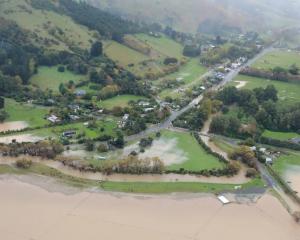
The ecologist has been leading research into low-flammable plants for the past 12 years, leading to the creation of the Plant Flammability Directory, which now has more than 470 plants listed.
To test the plants, Curran built a plant barbecue which uses a propane torch to burn samples.
“ We’ve worked out it’s well over 5000 samples (of plants) we’ve burned,” Curran said.
While it may seem as simple as just putting a blowtorch on the plants, Curran explained there is a bit more to the process.
“ We’re preheating that sample for two minutes to dry out the sample a bit further and volatilise some of the chemicals the plant has.
“Both of those things mimic an oncoming firefront.”
After preheating, the samples are blow-torched for 10 seconds, after which more measurements are taken including, the maximum temperature reached, how long the plant burns once the blowtorch is off, and the amount of the sample left unburnt.
Curran said New Zealand’s weather is changing to be more conducive to fire.
“The predictions, particularly for the eastern parts of New Zealand, are looking quite dire. We’re going to get drier landscapes, windier landscapes and lower humidity.”
Curran said the list has been used by the likes of Christchurch City Council to develop green fire breaks on the Port Hills. The fire breaks are strips of low-flammability plants strategically established across the landscape.
Curran and his team are now looking at ‘fighting fire with food’ – how green fire belts can be utilised on farms by using crops to halt the spread of fire.
“ We’ve got a wider list that we’re working through publication at the moment which includes a wide range of crop and pasture species.
“So with the idea being that you’d actually be able to have a really good think about how agricultural landscapes are designed from a fire mitigation point of view,” he said.

“ You can start to actually have low flammable green fire breaks playing a really important multinational role across the landscape and that I think is where we’ll get most bang for our buck and get most people.”

As part of the research, Curran said there were also some surprises.
“We’ve found that some of our native species are really highly flammable.
“One of the really surprising things for us was silver beech which is a very flammable species which we weren’t expecting because that’s found in the wetter rain forests.”
The plant flammability list is the result of a collaboration between Curran and Auckland University Professor George Perry, with help from three postdoctoral scholars – Dr Sarah Wyse, Dr Josep Padulles Cubino and Dr Azhar Alam, four PhD students Dr Azhar Alam, Dr Xinglei Cui, Dr Niger Sultana and Dr Shanta Budha-Magar, several masters and honours students, and many undergraduate students, summer scholars and international interns.
Said Curran: “It’s been a real privilege to be working with such a cool group on a project that’s now getting out there in the public’s hands, and the public can use the information that we’ve been producing.”
What you can do at your own home
Creating what is known as a defensible space is one of the key things that can be done to protect your home from wild fires. The space is made up of two zones.
Zone one – 0-10m around the house:
- Keep grass short
- Keep gutters and decks clear of dead leaves, debris and pine needles
- Remove highly flammable plants
- Store things such as firewood well away from the house.
Zone two – 10-30m around the house:
- Reduce or move trees so they are not touching
- Prune branches up to 2m from the ground.
- To learn more about low-flammability planting, visitcheckitsalright.nz/reduce-your-risk/low-flammability-plants













